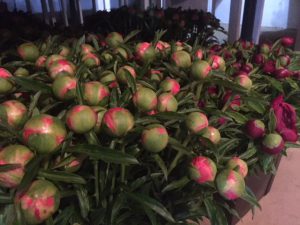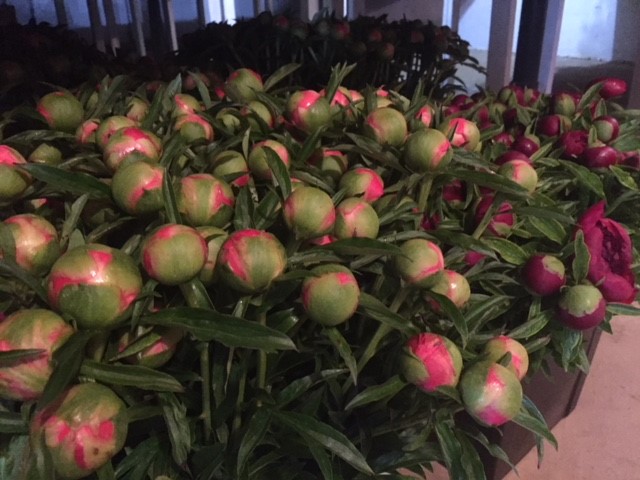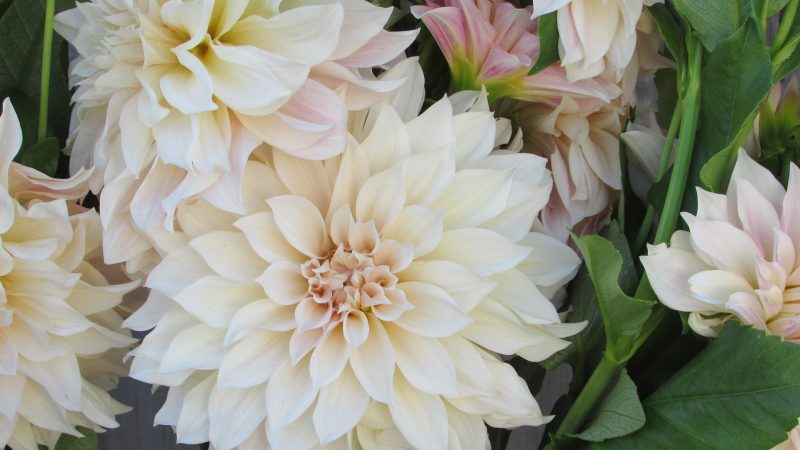While I love to share our products with you, I am super excited to have a place to share what we are all about at Cramers’ Farm! We feel how we do is just as important as what we do. From growing techniques and post-harvest procedures to labor practices and employee relationships – we approach things a little differently than other farms our size. These unique practices carry over to every aspect of the farm, including our wide variety of flowers.
Today, I want to share the how behind the process of adding new items to our selection of flowers. Often, we discover new items in trade publications or by talking to other growers. Listening to suggestions, feedback and requests from our customers about specific crops provides valuable information too. Next, we dig around to research what is a good fit with our farm. Production requirements, harvest times, input cost, post-harvest treatments and return on investment are key players in making decisions. We have learned that just because you can grow something doesn’t always mean that you should. When an item passes the initial requirements, we try growing a relatively small amount to see how it goes.
This season we tried several different selections, some out of necessity and others to add diversity to our offerings. Here are our impressions of a few varieties:

Hibiscus Mahogany Splendor
I encountered this crop late last summer at Wollam Gardens in Jeffersonton, VA. (Thanks Bob Wollam!) The clean, beautiful foliage reminded me of a Japanese maple tree but with burgundy stem color. We sourced seed and grew it in several locations on the farm – both inside our high tunnels and outside in the field production area. Several growers shared that it can be finicky about re-hydrating after harvest. Even with excessive heat and drought conditions, it performed perfectly for us! Look for this beauty next season as we put it into full-scale production.
Scabiosa
This one was driven by customer requests. (Thanks Tom and Persaud!) Years ago, we grew Scabiosa but stopped for various reasons. When it came time to look at it again, I was able to pick another grower’s brain about varieties and culture. (Thanks Jenny!) This year, we grabbed some mixed seed to see how it would perform on our farm. The plan for next year is to focus on solid color to meet market demands.
Dahlia: Souvenir de Ete and American Sun
Necessity drove trying these two selections. Our regular yellow dahlia (Karma series Ventura) was discontinued and we have been looking for a solid orange dahlia forever. Both of these tuber varieties produce tons of stems. The American Sun has a few drawbacks, thick stems and some russet color in the center on some blooms – but overall it’s a winner! Though the blooms are a little smaller than our usual dahlias, Souvenir has been pretty awesome with consistent production and a solid orange color. Both are likely to be back again next season.

Sunflower Pro-Cut Plum
This is a new offering from Germania in Chicago, the seed company from which we source most of our seeds. Corky Kane was nice enough to send us a small packet to try. While we really liked the look of this one and the shelf life is similar to other specialty suns, the real question is – where does it fit in our plan? We already grow dark brown Terra Cotta (our Cappuccino) and Pro-Cut bicolor (our Sundown). The Plum looks different, but is it different enough to add to what we already do? The small batch didn’t yield enough stems to send out to our customers for evaluation, so pictures will have to suffice. Consider this one a maybe for next season…
Dusty Miller
Customer requests and seeing it at another farm inspired us to try this one. Sadly, we were unable to attain enough stem length on the two varieties we grew. Plant mortality was also too high for our liking. I think with more TLC this could work, but realistically this is probably not going to make the cut.

Ranunculus
Talk about a winner! We have been trying to work tunnel-grown ranunculus into our program for a few years and think we finally have it nailed! The production area is small in comparison to other programs, but the final product is amazing. We started a few years ago by sourcing domestic corms, primarily Gigi and LaBelle, with some success. Another grower saw what we were able to accomplish with the domestic stock and said we just HAD to try using Italian corms. Suffice it to say; Andrea knew what she was talking about! We placed our first order late in 2015, so we had to take what we could get as far as varieties and size of corms, but it still made a world of difference. We’re so impressed that we purchased another 4 season high tunnel, doubling our ranunculus production area from 2500 sq. ft. to 5000 sq. ft. for the 2017 harvest season. Corms will go in the ground in a couple of weeks. If all goes well, we will start cutting in late March. We are using the Elegance Series and the Success Series, known in the market as Cloni, in various colors.
This is the ultimate high demand item! The corms are expensive, they require a lot of management, they are gorgeous with tall stems and big heads – and as you would expect – the final product is priced accordingly. This season, every customer who got our ranunculus wanted an exclusive to buy all of our production. Although we are flattered, that doesn’t fit how we want to operate. The numbers will be very limited compared to most of our products. But if you are interested – and okay with possibly being disappointed AND sharing with others – call your wholesaler in late March to see how we are making out.

















